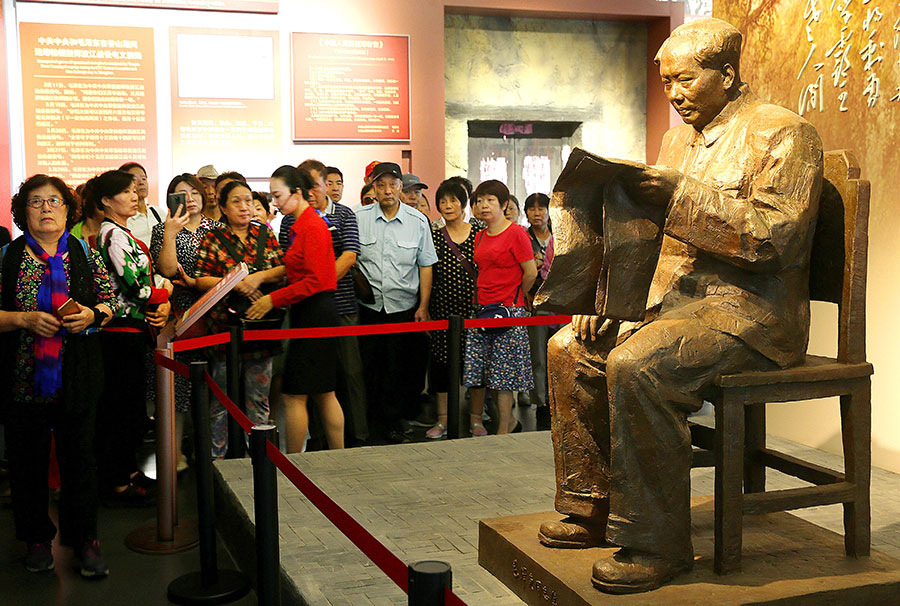Former revolutionary base becomes tourism magnet
By Xin Wen | China Daily | Updated: 2019-09-20 09:05

In the western suburbs of Beijing, Xiangshan Park, or the Fragrant Hills, is known as a prime place in China for viewing autumn foliage.
Now the red leaves have another meaning. More people have realized they symbolize the country's revolutionary years as eight revolutionary memorial sites in the area opened to the public. It has become a magnet for tourists who want to view historical relics and related cultural information.
In March 1949, the Communist Party of China Central Committee had its headquarters in the Fragrant Hills. Chairman Mao Zedong lived in Shuangqing Villa from which he directed the military campaign that sent soldiers across the Yangtze River and led to the collapse of the Kuomintang regime.
The Fragrant Hills was also a place where the important parts of the foundation of New China were laid.
Eight renovated revolutionary sites and a newly built museum in the Fragrant Hills tracking the moves of the Central Committee opened to the public on Sept 13 during the Mid-Autumn Festival.
The eight sites, including Shuangqing Villa, have been undergoing face-lifts for the past year. Work on the revolutionary memorial museum, which now displays about 800 photos and 1,200 cultural relics on the founding of the People's Republic of China, started at about the same time.
President Xi Jinping visited the villa and other revolutionary sites in the Fragrant Hills and viewed the exhibition at the museum on Sept 12. He recalled the history of the CPC leading the Chinese people to victory and honored the glory of the elder generation of revolutionaries, including Mao.
Xi said that even though the Central Committee spent only half a year at the Fragrant Hills, it was the headquarters from which the Party led the people to the successful conclusion of the War of Liberation (1946-49) - something of great significance in the country's history.
At 10 am on Tuesday, five exhibition halls at the new museum were crowded with more than 2,000 tourists interested in the history of the Fragrant Hills revolutionary base.
On March 23, 1949, the Central Committee and Mao left Xibaipo-a CPC base in Hebei province-for Beijing. Two days later, they moved to the Fragrant Hills, making it the seat of the committee at that time.
Some special items were also on exhibit at the museum, including two large red lanterns that had hung on Tian'anmen Gate in the city's center. Also on display were 10 ceremonial guns used during the founding ceremony for New China.
About 1.6 kilometers southwest of the museum are eight renovated revolutionary sites covering 3,600 square meters.
Shuangqing Villa and Laiqing Pavilion, where four Central Committee leaders lived and worked-including Zhu De, Liu Shaoqi, Zhou Enlai and Ren Bishi-drew the most attention from visitors.
Dozens of guest books in the pavilion are filled with tourists' memories of the revolutionary pioneers.
Replicas of furniture, as well as office supplies and wall maps, are arranged in the pavilion based on their original appearance.
In Zhou Enlai's office, a replica of a radio transceiver using direct-current and alternating-current power stood out. Seized during a battle at Xuchang, Henan province, the transceiver was first used by Chen Yi, commander of the East China Field Army. It was later given to Zhou.
A jeep made in the United States, the same type of vehicle that Mao took to review troops at Xiyuan Airport in Beijing, also caught the eye of visitors. Many tourists passing near Shuangqing Villa snapped photos of the green jeep.
Xu Lisheng, a 40-year-old financial sector worker who toured Laiqing Pavilion on Tuesday, said that as the first stop in Beijing for Mao and the Central Committee, the Fragrant Hills were significant for him in understanding how the older generation of revolutionaries had worked before the founding of the country.
As of Tuesday, the eight revolutionary sites had received around 73,000 visitors since they opened on Sept 13. Of those visitors, 34,000 toured Shuangqing Villa, Fragrant Hills park authorities said.
Tourists can make reservations by telephone from 9 am to 4 pm daily except Mondays for free visits to the memorial museum. A website appointment system is coming soon, the park administration said. Tickets are also sold at the park's gate.
Zhao Beihua, 65, from Chaoyang district, said he used to think of the Fragrant Hills only as a large outdoor park and ignored its red revolutionary cultural resources.
As an urban youth who experienced life working in rural areas of the Inner Mongolia autonomous region for 10 years in the 1970s, Zhao said the opening of the revolutionary site provides a precious opportunity for him to further understand the history of the CPC and the founding of the People's Republic of China.
"It also caused me to reminisce about bygone days when I lived in rural areas, and it brought about warm feelings toward the homeland," he said.























